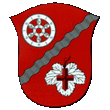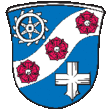As part of the re-division of local government in Hesse, seven municipalities (now Heppenheim’s districts) were merged with the town core on the 1st January, 1972. Today, the preservation and conservation of the districts’ rural structures contribute to Heppenheim’s positive image overall. As part of the administrative district’s capital town, the districts set great store by preserving their typical character and a welcoming and maintaining a welcoming community spirit.

Districts
Erbach
This village was first mentioned as Erpbach in the 12th century in the Codex Laureshamensis, or Lorsch Codex. Erbach lies in a basin and was formerly (apart from two brick furnaces) entirely agricultural. Through private-sector construction activity, the village grew into a residential development in an idyllic setting in the second half of the 20th century. The multi-purpose hall, which was built with considerable personal contributions from the townspeople of Erbach, has also made the district, which has taken part in the “Unser Dorf” (Our Village) competition several times, a popular venue for events. Link: www.heppenheimerbach.deOrtsvorsteherin: Frau Ursula Hammann | Im Vordersberg 38 | 64646 Heppenheim

Hambach / Ober-Hambach
The villages of Ober- and Unter-Hambach probably sprang up in the Hambacher Tal valley in the 10th century. The twelve mills, which are driven by water power from the Hambach stream, were of particular economic significance. Because it was the location of the Odenwaldschule school, which was opened in 1910, the smaller village of Ober-Hambach had already attracted many visitors from far and wide. The integration of the school buildings into the landscape of the Odenwald region can be regarded as an adequate architectural interpretation of the Odenwaldschule’s progressive approach to education. Link: www.hambach-info.deOrtsvorsteher: Herr Wolfgang Schlapp | Wertheimer Straße 24 | 64646 Heppenheim

Kirschhausen / Igelsbach
The first documentary record of Kirschhausen is in 1130 in the Lorsch Codex, where it is mentioned under the name Kirzehusen. From 1821 onward, together with Erbach, Sonderbach and Wald-Erlenbach, the village formed the Vierdorf-Gemeinde, a four-village municipality with Kirschhausen as its administrative centre. Today, with more than 2,200 inhabitants, Kirschhausen is Heppenheim’s largest district. Since the Middle Ages, the settlement of Igelsbach had comprised three farms. In the first half of the 19th century, a fourth farmstead was added through land division. In 1970, Igelsbach became part of Kirschhausen and two years later, together with Kirschhausen, a district of Heppenheim.Ortsvorsteher: Herr Peter Engelhardt | Heinrich-Weber-Straße 50 | 64646 Heppenheim

Mittershausen / Scheuerberg
Mittershausen-Scheuerberg received its first documentary mention in 1339. Well-kept half-timbered houses, some of which were built as early as the Thirty Years War, are still standing there. Both villages are in the Pfalzbachtal valley, whose name harks back to the time when Mittershausen and Scheuerberg were under Palatinate suzerainty. Long after the two villages had come under a single administration, the local sub-districts were officially merged in the 19th century.Ortsvorsteherin: Frau Gabriele Pfeifer | Am Pfalzbach 7 | 64646 Heppenheim

Ober-Laudenbach
Ober-Laudenbach is first mentioned in official documents as early as 795 under the name Lutenbach. All around the district, burial mounds can be found that date back to the Late Stone Age about 2000 B.C. The district forms an enclave of the State of Hesse within the State of Baden-Württemberg. Originally forming a joint settlement with Laudenbach, Ober-Laudenbach became an independent municipality at the latest in the 12th century. Its border location also contributed to the village becoming the scene of a battle between supporters of the revolution and counter-revolutionary Hessian troops in 1849.Ortsvorsteher: Herr Dr. Sebastian Lang | Steinkopfweg 22 | 64646 Heppenheim

Sonderbach
Sonderbach is first mentioned around 1200 in the Lorsch Codex. Local historians presume that the settlement was established around 1000 A.D. However, burial mounds indicate that there were settlements in the valley already more than 4000 years ago. The Sonderbach quarries enjoy a tradition of more than one hundred years. Their high-quality granite has been used for building projects and monuments far beyond the region’s boundaries. The quarrying industry transformed the village, which up to then had been purely agricultural, into a workers’ community. The population has more than doubled since 1950.Ortsvorsteher: Herr Thomas Eck | Kreiswaldweg 1 | 64646 Heppenheim

Wald-Erlenbach
Wald-Erlenbach is first mentioned in documents in 1409 as “Erlenbach”. Its current nomenclature dates back to 1682. The district of Wald-Erlenbach is Heppenheim’s outpost to the Odenwald region and is located eleven kilometres away from Heppenheim. Particularly because of the lively construction activity of the last 50 years, a district developed with some 740 inhabitants, set in the charming Odenwald landscape, from what was originally a settlement comprising only a few farmsteads.Ortsvorsteherin: Frau Heidrun-Barbara Jäger | Wiesentalstraße 10 | 64646 Heppenheim


